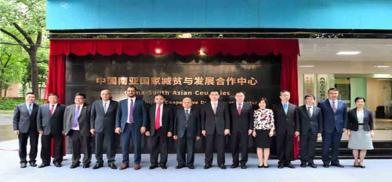China's growing economic engagement in South Asia is a warning to India
China has already surpassed India in its volume of trade with Bangladesh and is fast catching up to replace it as the top trading partner of Sri Lanka and Nepal. It has extended aid and financial assistance to these states that surpass India’s aid to them

A Chinese ship docked at Hambantota in the third week of August 2022 with Sri Lanka and China calling it a marine scientific research vessel docking briefly on the port for “replenishment of supplies and equipment”. But foreign security experts call it a Chinese naval ship that's been used in the past to track satellites and missiles.
The ship's arrival had the alarm bells ringing in the West and in neighbouring India. According to critics, whatever China does in Hambantota with this ship may signal what it eventually plans to do with all the ports, highways, bridges and other infrastructure it has built around the world in recent decades. They fear this colossal infrastructure network could be converted into an unprecedented network of military bases, occupying parts of countries where China has never had overseas army bases.
Recently, Sri Lanka has been one of the countries hardest hit by inflation and rising energy prices. In May 2022, the government defaulted on foreign debt payments. By July 2022, inflation had shot up to 60 per cent. There are rolling blackouts, food shortages and fuel rationing. The economic crisis sparked a political one: protesters filled the streets, calling for the ouster of President Gotabaya Rajapaksa. In July 2022, he fled the country and resigned. A new president is now in his place.
China’s financing and operation of Sri Lanka’s Hambantota port, where a Chinese surveillance vessel docked this week despite objections from the United States and India, have been raised as a cautionary example of 'debt trap diplomacy' - a strategy in which a country loans money to smaller nations, which may not be able to repay their debts, as a way to boost geopolitical influence. Some even blame China for the island nation’s economic nosedive. Yet experts say Sri Lanka’s debt crisis is more complicated, and China is just one player, albeit an important one.
When Yuan Wang 5 docked at Sri Lanka’s Hambantota port – despite objections raised by India – experts said it showed how Beijing is using its economic heft to extend its power in the region.
China-Sri Lanka economic engagement
The total trade between the two countries has been steadily increasing over the years and had more than doubled over the three-year period from 2009 (US$1,085 million) to 2012 (US$2,775 million). Currently, China exports goods and services worth US $4.1 billion to Sri Lanka while Sri Lankan exports to China are worth US $266 million.
While Sri Lankan exports to China have grown over the last five years, imports from China have grown at a significantly larger rate, resulting in a rapidly expanding trade deficit of US$2559 million - more than double the deficit of US$973 million in 2009. According to Saman Kelegama, had a Free Trade Agreement not existed between India and Sri Lanka, China would have become the largest trading partner of Sri Lanka by now. Also, Sri Lanka and China are part of the APTA (Asia Pacific Trade Agreement) which is an avenue that expands trade between the two countries.
In the area of Investment, China has emerged as the leading source of Official Development Assistance (ODA) and Foreign Direct Investment (FDI) in Sri Lanka worth almost $14 billion. China’s flagship projects - the Hambantota Port Development and the Colombo Port Project - are both supported by loans and located at strategic points on the global sea trade route. There has been in fact an agreement between the two countries that all Chinese entrepreneurs who invest a minimum of US$ 25 million be provided with a Sri Lankan passport on the basis of a “second-home” passport.
When it comes to aid and technical assistance, China has been an important donor in Sri Lanka contributing to various infrastructural projects like Nilabe hydropower station, the Supreme Court complex etc. China replaced Japan as the highest donor to Sri Lanka. In fact, Sri Lanka owed an aid of more than US$1billion to China in 2014. China assists Sri Lanka in various disaster reconstruction projects, humanitarian aid and energy projects as well.
Sri Lanka currently owes 10 per cent of its overall debt and 20 per cent of its debt stock to China—the highest amongst its bilateral lenders. Chinese loans have been maturing in recent years and occupying a large proportion of Sri Lanka’s repayment scheme. Sri Lanka’s total public and publicly guaranteed debt was $35.8 billion at the end of 2021. Of that amount, lending by China accounted for $7.1 billion, or 20 per cent, compared with less than 1 per cent in 2001, according to data from Sri Lanka’s finance ministry.
Implications for South Asia
Vikram Sood, an ex intelligence official and a strategic analyst, observes that ,”China and India with two of the largest armies in the world, each equipped with nuclear weapons in countries with the largest growing economies and with the largest populations, have an un-demarcated border where they face each other despite the growing trade and yet, China will not agree to let India become a member of the UNSC, NSG or agree to the UN designating Masood Azhar of Jaish-e-Mohammed as a terrorist despite the Jaish’s involvement in the Pathankot attack and terrorism in India, nor agree to name Pakistan as a state sponsor of terrorism, as it did at the recent BRICS Summit. The idea is to keep India on the backfoot”. China’s economic cooperation policy towards other South Asia states too is seen an extension of its bid to undercut India’s influence in the region where it has a natural advantage owing to its large territory and shared historical and cultural ties.
Further, economic dependence of other smaller nations on China brings the threat of them falling into the Chinese “debt-trap”. China has already surpassed India in its volume of trade with Bangladesh and is fast catching up to replace it as the top trading partner of Sri Lanka and Nepal. It has extended aid and financial assistance to these states that surpass India’s aid to them. It has successfully been able to bring in Sri Lanka, Bangladesh and Nepal in its extensive framework of road and rail connectivity as they all become a part of its Belt and Road Initiative. Also, the large construction projects financed by China in areas of trade and energy connectivity, electricity plants, etc. provides China with some added level of diplomatic leverage with these states.
In addition, it threatens the process of South Asian regional integration in the long term as successful integration involves the presence of an anchor economy to take the process forward that could absorb the risks involved in integrating, as Indonesia had been to ASEAN and Germany had been to the EU. As some South Asian countries look more towards China as an alternative to India, the prospects for South Asian Integration appear to be diminishing. The inactivity with regard to SAARC and other integration mechanisms has stemmed from a lack of committed leadership and direction leading to discord, uncertainty, lack of consensus, and faith in India's primacy and leadership role in the region.
The onus falls on India to take a flexible approach in the South Asian integration process and, in some cases, to waive reciprocity rules for its neighbouring smaller nations.
(The author is a Research Scholar, Centre for South Asian Studies, School of International Studies Jawaharlal Nehru University, New Delhi. Views are personal. She can be contacted at goswaminidhi1994@gmail.com)










Post a Comment